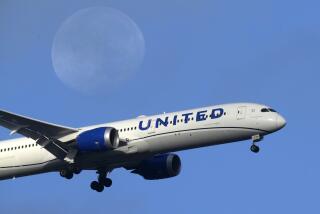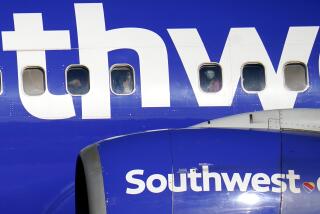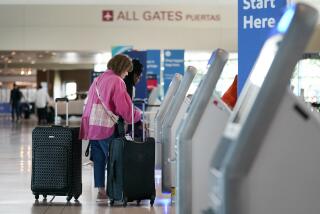Triple Mileage: Airlines Fly Into Turbulent Skies
With the latest round of triple mileage offers to frequent fliers, the airlines have finally, it seems, taken leave of their senses.
There seems little doubt that the airlines are putting themselves in a potentially hazardous position by allowing their customers to pad their mileage accounts by three times as many miles as they actually fly.
The hazard is that the airlines are running up an indebtedness to frequent-flier club members of hundreds of millions, maybe billions, of miles.
If there is an unusually high demand--all at the same time--for redemption of the free seats, the airlines simply can’t deliver. Passengers will get angry and, more important, so will law enforcement authorities.
The air transportation industry has been put on notice by the attorneys general of the 50 states that it can’t convert the mileage at the airlines’ pleasure. Fliers’ rights are now being protected as never before.
Airlines are betting there won’t be a run on the bank. Normally, only a small number of frequent-flier club members convert their miles to tickets at any given time.
Signs of Trouble
Some airlines already are having trouble finding seats to sell because of all the free transportation they’re giving away to frequent fliers. A small increase in demand and it may be crisis time.
The battle began innocently enough, or so it seemed.
Delta Airlines promised to credit its customers with triple mileage for flights flown this year on tickets purchased with an American Express card--provided they registered in advance through a well-advertised toll-free telephone number.
It was a joint promotion, part of the cost being underwritten by the credit-card company, part by Delta.
On the surface, it seemed a plus for both.
Unfortunately, in the airline business, no company ever gets too big a jump for too long, no matter how innovative the approach. Competitors lined up to do Delta one better.
Responses differed from company to company. But essentially, most will credit accounts with three times the miles flown through the remainder of 1988, provided one round trip or two one-way flights are taken before March 31.
Bonanza for Passengers
The airlines are trying to hype soft first-quarter sales by holding out the carrot of triple miles for the year.
It’s a bonanza for passengers. A business executive friend belongs to the Delta, United and Continental/Eastern programs. He belongs to these three because his travel patterns tend to fall into their route networks. It’s not unusual for people to belong to several plans.
He calculated, based on the number of trips he expects to take on each--and those he is determined to take before March 31--what he’ll get as free transportation by the time the triple-mileage promotions end. Figuring what he has already earned, Delta could owe him eight free trips, United 10 and Continental/Eastern 12 by the end of the year.
He assures me there are people in his firm whose entitlements are greater for 1989.
The only way he could hope to use all of his free travel would be for business trips.
The war to establish brand loyalty, which is what frequent-flier programs are all about, is a dream scheme for passengers. It may turn out to be a nightmare for airlines.
For the record, they say they can handle it. Privately, many are deeply concerned.
Not many are wild about the frequent-flier concept anyway. Even before this new giveaway frenzy, these programs had become unchecked monsters.
Clamoring for Trips
Says one major airlines executive: “Tell me where I’m supposed to find the seats to satisfy these passengers when they start clamoring for their free trips later this year. There just aren’t enough to go around . . . not if we want to keep a few to sell, as well.”
That is the nub of the matter. How can the airlines make a profit selling seats when they’re forced to give them away?
Of course, they can make the free seats available on a capacity-controlled basis, allowing only a certain number of any given flight. The trouble is that they no longer seem to have the right to decide for themselves what that number should be.
California Attorney General John Van de Kamp announced that he wants a “reasonable” percentage of seats on every flight to be available for use by frequent-flier members, although he hasn’t defined reasonable. Van de Kamp also stipulated that passengers may not be put off with “we can’t accommodate you until next spring,” or any similar excuse.
Simply put, the new rules are supposed to give frequent-flier members what they’ve earned within two weeks of their requested departure date.
The airlines shouldn’t think that this is just so much politicking by law enforcement officials in Sacramento. The tougher stance on consumer rights is for real.
Holding Their Breath
The triple-mileage windfall is due to expire at the end of this year. Airlines are holding their breath, hoping that a competitor doesn’t extend it. If so, all would then have to extend it.
This kind of promotion seldom changes market share significantly. As soon as the airlines match the originator, passengers stay with their chosen mileage plans . . . but under greatly enhanced conditions.
The program in its present form should die on schedule. But two things may happen in 1989.
Triple (or double or quadruple) mileage may be offered by some airlines on weak flights. It could be for off-peak departures, or on market segments that aren’t doing well, or to introduce new services.
For whatever reason, some airlines will probably continue to offer mileage incentives to frequent fliers in a modified form.
Second, airlines may allow frequent fliers to use their earned miles to buy non-airline goods and services. For example: Take 50,000 miles along to the nearest appliance store and get 25% off the price of a refrigerator.
More to Read
Sign up for The Wild
We’ll help you find the best places to hike, bike and run, as well as the perfect silent spots for meditation and yoga.
You may occasionally receive promotional content from the Los Angeles Times.





